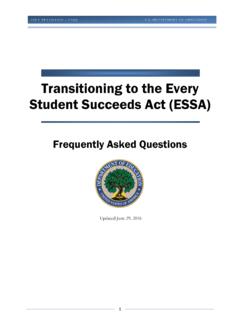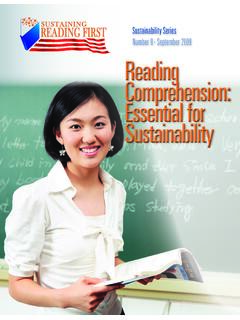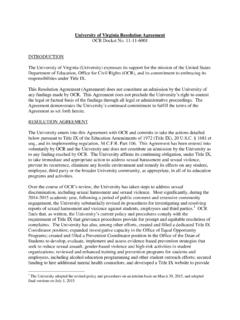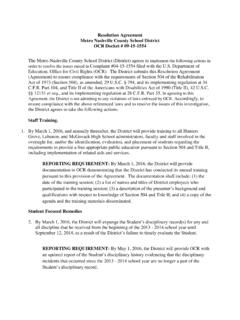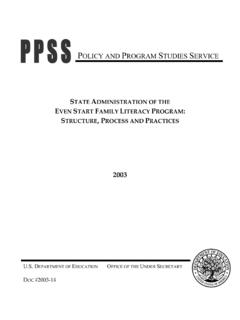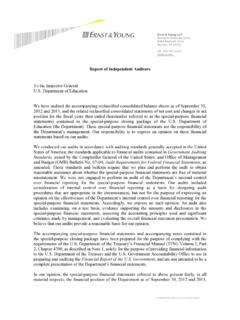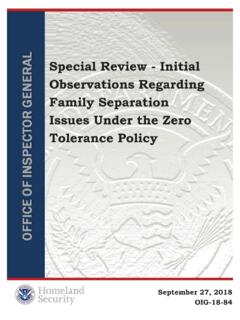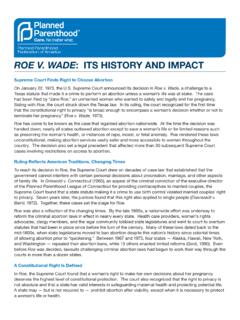Transcription of U.S. Department of Justice U.S. Department of Education
1 Department of Justice Civil Rights Division Department of Education Office for Civil Rights January 7, 2015 Dear Colleague: Forty years ago, the Supreme Court of the United States determined that in order for public schools to comply with their legal obligations under Title VI of the Civil Rights Act of 1964 (Title VI), they must take affirmative steps to ensure that students with limited English proficiency (LEP) can meaningfully participate in their educational programs and That same year, Congress enacted the Equal Educational Opportunities Act (EEOA), which confirmed that public schools and State educational agencies (SEAs) must act to overcome language barriers that impede equal participation by students in their instructional Ensuring that SEAs and school districts are equipped with the tools and resources to meet their responsibilities to LEP students, who are now more commonly referred to as English Learner (EL)
2 Students or English Language Learner students, is as important today as it was then. EL students are now enrolled in nearly three out of every four public schools in the nation, they constitute nine percent of all public school students, and their numbers are steadily It is crucial to the future of our nation that these students, and all students, have equal access to a high-quality Education and the opportunity to achieve their full academic potential. We applaud those working to ensure equal educational opportunities for EL students, as well as the many schools and communities creating programs that recognize the heritage languages of EL students as valuable assets to preserve. The Office for Civil Rights (OCR) at the Department of Education (ED) and the Civil Rights Division at the Department of Justice (DOJ) share authority for enforcing Title VI in the Education context.
3 DOJ is also responsible for enforcing the EEOA. (In the enclosed guidance, Title VI and the EEOA will be referred to as the civil rights laws. ) In addition, ED administers the English Language Acquisition, Language Enhancement, and Academic Achievement Act, also known as Title III, Part A of the Elementary and Secondary Education Act of 1965, as amended (ESEA) (Title III).4 Under Title III, ED awards grants to SEAs, which, in turn, award Federal funds through subgrants to school districts in order to improve the 1 Lau v. Nichols, 414 563 (1974); 42 2000d to d-7 (prohibiting race, color, and national origin discrimination in any program or activity receiving Federal financial assistance). 2 Pub. L. No. 93-380, 204(f), 88 Stat. 484, 515 (1974) (codified at 20 1703(f)). 3 Department of Education , National Center for Education Statistics, NCES 2013-312, Characteristics of Public and Private Elementary and Secondary Schools in the United States: Results From the 2011-12 Schools and Staffing Survey, at 9 (Table 2) (Aug.)
4 2013); Department of Education , National Center for Education Statistics, NCES 2014-083, The Condition of Education 2014, at 52 (Indicator 12) (May 2014). 4 20 6801-6871. Page 2 Dear Colleague Letter: English Learner Students and Limited English Proficient Parents Education of EL students so that they learn English and meet challenging State academic content and achievement The Departments are issuing the enclosed joint guidance to assist SEAs, school districts, and all public schools in meeting their legal obligations to ensure that EL students can participate meaningfully and equally in educational programs and This guidance provides an outline of the legal obligations of SEAs and school districts to EL students under the civil rights Additionally, the guidance discusses compliance issues that frequently arise in OCR and DOJ investigations under Title VI and the EEOA and offers approaches that SEAs and school districts may use to meet their Federal obligations to EL students.
5 The guidance also includes discussion of how SEAs and school districts can implement their Title III grants and subgrants in a manner consistent with these civil rights obligations. Finally, the guidance discusses the Federal obligation to ensure that LEP parents and guardians have meaningful access to district- and school-related information. We hope that you will find this integrated guidance useful as you strive to provide EL students and LEP parents equal access to your instructional programs. As we celebrate the fortieth anniversaries of Lau and the EEOA and the fiftieth anniversary of Title VI, we are reminded of how much progress has been achieved since these milestones and how much work remains to be done. We look forward to continuing this progress with you. Sincerely, /s/ Catherine E. Lhamon Assistant Secretary for Civil Rights Department of Education /s/ Vanita Gupta Acting Assistant Attorney General for Civil Rights Department of Justice 5 20 6821(a), 6825(a); see also 34 (b), (c) (explaining distinction between content standards and achievement standards).
6 6 The terms program, programs, programs and services, and programs and activities are used in a colloquial sense and are not meant to invoke the meaning of the terms program or program or activity as defined by the Civil Rights Restoration Act of 1987 (CRRA). Under the CRRA, which amended Title VI, Title IX of the Education Amendments of 1972 (Title IX), and Section 504 of the Rehabilitation Act of 1973 (Section 504), the term program or activity and the term program, in the context of a school district, mean all of the operations of a school district. 42 2000d-4a(2)(B); 20 1687(2)(B); 29 794(b)(2)(B). 7 As applied to Title VI, this guidance is consistent with and clarifies previous Title VI guidance in this area including: Department of Health, Education , and Welfare, Office for Civil Rights, Identification of Discrimination and Denial of Services on the Basis of National Origin (May 25, 1970), reprinted in 35 Fed.
7 Reg. 11,595 (July 18, 1970) (1970 OCR Guidance) (the great majority of programs and functions assigned to ED at its creation in 1980 were transferred from HEW); OCR, The Office for Civil Rights Title VI Language Minority Compliance Procedures (December 1985) (1985 OCR Guidance); and OCR, Policy Update on Schools Obligations Toward National-Origin Minority Students with Limited-English Proficiency (September 1991) (1991 OCR Guidance). These guidance documents are available at This guidance clarifies these documents and does so consistent with legal developments since 1991. When evaluating compliance under the EEOA, DOJ applies EEOA case law as well as the standards and procedures identified in this guidance, which are similar to those identified in OCR s previous Title VI guidance. Page 3 Dear Colleague Letter: English Learner Students and Limited English Proficient Parents Notice of Language Assistance Notice of Language Assistance: If you have difficulty understanding English, you may, free of charge, request language assistance services for this Department information by calling 1-800-USA-LEARN (1-800-872-5327) (TTY: 1-800-877-8339), or email us at: Aviso a personas con dominio limitado del idioma ingl s: Si usted tiene alguna dificultad en entender el idioma ingl s, puede, sin costo alguno, solicitar asistencia ling stica con respecto a esta informaci n llamando al 1-800-USA-LEARN (1-800-872-5327) (TTY: 1-800-877-8339), o env e un mensaje de correo electr nico a.
8 1-800-USA-LEARN (1-800-872-5327) ( 1-800-877-8339), : Th ng b o d nh cho nh ng ng i c kh n ng Anh ng h n ch : N u qu v g p kh kh n trong vi c hi u Anh ng th qu v c th y u c u c c d ch v h tr ng n ng cho c c tin t c c a B d nh cho c ng ch ng. C c d ch v h tr ng n ng n y u mi n ph . N u qu v mu n bi t th m chi ti t v c c d ch v phi n d ch hay th ng d ch, xin vui l ng g i s 1-800-USA-LEARN (1-800-872-5327) (TTY: 1-800-877-8339), ho c email: : , .. , 1- 800-USA-LEARN (1-800-872-5327) 1-800-877-8339 . Paunawa sa mga Taong Limitado ang Kaalaman sa English: Kung nahihirapan kayong makaintindi ng English, maaari kayong humingi ng tulong ukol dito sa inpormasyon ng Kagawaran mula sa nagbibigay ng serbisyo na pagtulong kaugnay ng wika.
9 Ang serbisyo na pagtulong kaugnay ng wika ay libre. Kung kailangan ninyo ng dagdag na impormasyon tungkol sa mga serbisyo kaugnay ng pagpapaliwanag o pagsasalin, mangyari lamang tumawag sa 1-800-USA-LEARN (1-800-872-5327) (TTY: 1-800-877-8339), o mag-email sa: Уведомление для лиц с ограниченным знанием английского языка: Если вы испытываете трудности в понимании английского языка, вы можете попросить, чтобы вам предоставили перевод информации, которую Министерство Образования доводит до всеобщего сведения. Этот перевод предоставляется бесплатно. Если вы хотите получить более подробную информацию об услугах устного и письменного перевода, звоните по телефону 1-800-USA-LEARN (1-800-872-5327) (служба для слабослышащих: 1-800-877-8339), или отправьте сообщение по адресу: Page 4 Dear Colleague Letter: English Learner Students and Limited English Proficient Parents Dear Colleague Letter: English Learner Students and Limited English Proficient Parents TABLE OF CONTENTS8 I.
10 State Educational Agency and School District Obligations to EL Students ..5 II. Common Civil Rights Issues ..8 A. Identifying and Assessing All Potential EL Students ..10 B. Providing EL Students with a Language Assistance Program ..12 C. Staffing and Supporting an EL Program ..14 D. Providing Meaningful Access to All Curricular and Extracurricular Programs ..17 1. Core Curriculum ..18 2. Specialized and Advanced Courses and Programs ..21 E. Avoiding Unnecessary Segregation of EL Students ..22 F. Evaluating EL Students for Special Education Services and Providing Special Education and English Language Services ..24 1. Individuals with Disabilities Education Act (IDEA) ..25 2. Section 504 of the Rehabilitation Act (Section 504) ..27 G. Meeting the Needs of EL Students Who Opt Out of EL Programs or Particular EL Services ..29 H. Monitoring and Exiting EL Students from EL Programs and Services.



